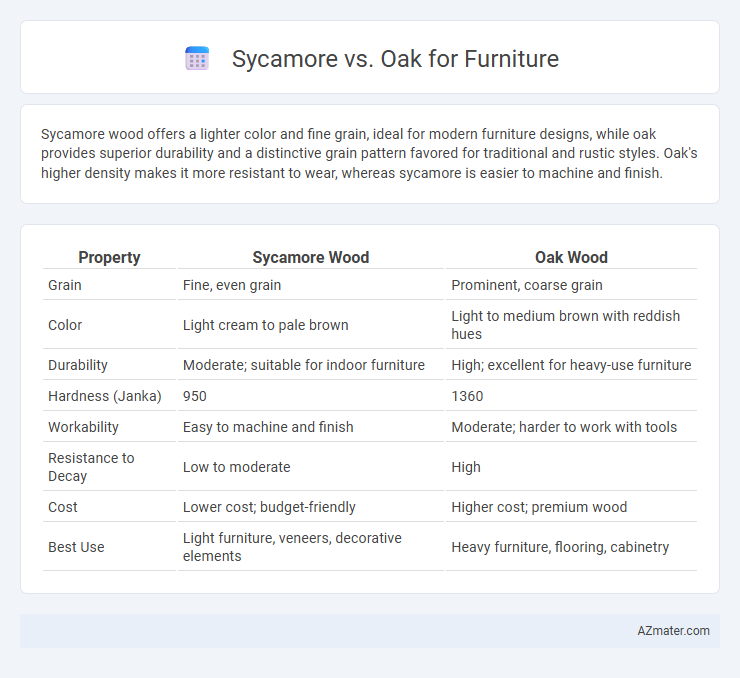Sycamore wood offers a lighter color and fine grain, ideal for modern furniture designs, while oak provides superior durability and a distinctive grain pattern favored for traditional and rustic styles. Oak's higher density makes it more resistant to wear, whereas sycamore is easier to machine and finish.
Table of Comparison
| Property | Sycamore Wood | Oak Wood |
|---|---|---|
| Grain | Fine, even grain | Prominent, coarse grain |
| Color | Light cream to pale brown | Light to medium brown with reddish hues |
| Durability | Moderate; suitable for indoor furniture | High; excellent for heavy-use furniture |
| Hardness (Janka) | 950 | 1360 |
| Workability | Easy to machine and finish | Moderate; harder to work with tools |
| Resistance to Decay | Low to moderate | High |
| Cost | Lower cost; budget-friendly | Higher cost; premium wood |
| Best Use | Light furniture, veneers, decorative elements | Heavy furniture, flooring, cabinetry |
Introduction to Sycamore and Oak Woods
Sycamore wood is known for its fine, even texture and pale, creamy color with subtle grain patterns, making it ideal for detailed woodworking and furniture that emphasizes a smooth finish. Oak wood offers a robust, coarse grain structure with rich, warm hues ranging from light brown to deep reddish tones, prized for its strength and durability in heavy-use furniture pieces. Both woods are valued in furniture making, with sycamore favored for its workability and oak for its resilience and classic aesthetic.
Key Characteristics of Sycamore Wood
Sycamore wood is known for its fine, even texture and pale, creamy color that darkens slightly with age, making it a popular choice for light-toned furniture. Its hardness and strength provide excellent durability, while the interlocked grain pattern offers resistance to splitting, ideal for both structural and decorative pieces. Compared to oak, sycamore features a smoother finish with less pronounced grain patterns, appealing to those seeking a more subtle, elegant look in furniture design.
Key Characteristics of Oak Wood
Oak wood is known for its durability, strength, and prominent grain patterns, making it a popular choice for furniture that demands longevity and aesthetic appeal. It features high resistance to wear and dents, with a dense texture that supports heavy use over time. The natural color of oak ranges from light tan to medium brown, often enhanced by staining to highlight its coarse, open grain structure.
Appearance and Grain Comparison
Sycamore wood displays a pale cream to light brown color with subtle, wavy grain patterns, offering a smooth and uniform appearance ideal for contemporary furniture designs. Oak features a richer, golden to medium brown hue with pronounced, coarse grain patterns that provide robust texture and a classic, traditional look in furniture pieces. While sycamore's fine grain creates a refined finish, oak's distinct grain enhances durability and adds visual depth, making each suitable for different aesthetic preferences.
Durability and Strength Differences
Sycamore furniture offers moderate durability with a fine, even grain that provides a smooth finish but is generally softer and less impact-resistant compared to oak. Oak is renowned for its exceptional strength and hardness, making it highly durable and ideal for heavy-use furniture that requires long-lasting structural integrity. The increased density and robust cellular structure of oak result in superior resistance to dents and scratches, enhancing its longevity over sycamore in demanding environments.
Workability for Furniture Making
Sycamore wood offers excellent workability due to its fine, even grain and moderate hardness, making it easy to cut, shape, and sand for detailed furniture pieces. Oak, while harder and denser, provides superior durability but requires sharper tools and more effort during machining, especially for intricate designs. Both woods hold finishes well, but sycamore's smoother texture allows for a finer finish ideal for refined furniture surfaces.
Cost and Availability of Sycamore vs Oak
Sycamore wood is generally more affordable than oak, making it a cost-effective choice for budget-conscious furniture makers. Oak, especially white and red oak, tends to be pricier due to its durability and wide demand in high-quality furniture production. While oak is more widely available in large lumberyards and specialty wood suppliers, sycamore is less common and often sourced from smaller suppliers or regional sawmills.
Finishing and Staining Capabilities
Sycamore wood offers a smooth, even grain that absorbs stains uniformly, making it ideal for achieving light to medium finishes with a clear, natural appearance. Oak features a prominent grain that enhances texture and allows for deeper, richer stains, ideal for traditional furniture with a warm, classic look. Both woods respond well to finishes, but sycamore excels in consistent color application, while oak provides more pronounced grain contrast after staining.
Best Furniture Applications for Each Wood
Sycamore's fine grain and light color make it ideal for delicate furniture pieces like cabinets, veneers, and table tops that benefit from smooth finishes and intricate detailing. Oak's strength and durability suit heavy-use furniture such as dining tables, chairs, and flooring, where robustness and natural grain patterns enhance longevity and aesthetic appeal. Choosing between sycamore and oak depends on desired furniture function, with sycamore excelling in decorative, light-use applications and oak preferred for structural, high-traffic items.
Which is Better: Sycamore or Oak for Furniture?
Oak offers superior durability and a pronounced grain pattern, making it ideal for heavy-use furniture and traditional designs. Sycamore, with its lighter color and smoother texture, is favored for modern, minimalist furniture but is less resistant to dents and scratches. Choosing between sycamore and oak depends on the desired aesthetic and durability requirements for the furniture piece.

Infographic: Sycamore vs Oak for Furniture
 azmater.com
azmater.com